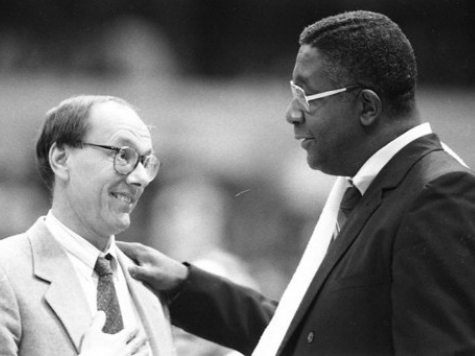
One of the prized editions of my two-trunk Sports Illustrated collection growing up was a number with Villanova’s Dwayne McClain, Chris Mullin of St. John’s, and Georgetown’s Patrick Ewing sharing the cover. Three teams from one conference competing in the 1985 Final Four really captured the Big East moment. If you came of age during the 1980s–wore out an Atari 2600, watched Martha Quinn introduce Nena’s “99 Luftballoons,” rode in the back of the family station wagon–and displayed even a remote interest in sports, then Big East basketball played as a big deal.
It doesn’t much now, which prompted Ezra Edelman to create a film wondering why. Discovering that Edelman, the documentarian behind ESPN’s “Requiem for the Big East,” shares roughly the same years on planet Earth with me didn’t surprise. Though the league won more national championships in the last decade than it did during the 1980s, the Big East Era coincided with the Reagan Era. And since we live in an age when you can Facebook friend a long-lost junior high acquaintance, order on iTunes the songs we danced to at the prom, and YouTube yourself to sleep on childhood pop-culture memories, the vision of Creighton and Butler playing in a Big East matchup jars something terribly to those who remember when the Big East lived up to its name.
Why can’t a DeLorean ride us back into ’85, too?
The Big East was about big cities. Patrick Ewing, Michael Adams, Ed Pinckney, Pearl Washington, Chris Mullin, and other hardwood stars grew up in the gritty environments that colored the league’s hardnosed play. Physical rather than finesse, the Big East reflected the playground courts in which Ewing and company became legends. It wasn’t exactly tackle basketball, but the referees weren’t exactly whistle-happy, either. “We weren’t dirty,” Ewing insists. “We were physical.”
Those northeastern cities developed the character of the conference. They also ensured big-money broadcasting contracts. Boasting teams in Boston, New York, Philadelphia, Washington, DC, and other Eastern media meccas, the Big East was quite literally a made-for-TV league. The ESPN documentary boasts that 54 of the Big East’s 56 games in 1983 played out on the small-screen. Playground heroes seeking to showcase their talents on a pixelated stage naturally flocked to Syracuse, Georgetown, St. John’s, and their competitors. Whereas Kareem Abdul-Jabbar, arguably the greatest college basketball player of all time, eagerly fled the Big Apple for UCLA in the 1960s, northeastern high school players in the 1980s stayed home.
The coaches who convinced them to were an especially charismatic and eclectic lot. P.J. Carlesimo’s East Coast volume, Rollie Massimino’s histrionics, Lou Carnesecca’s sweaters, and John Thompson’s size provided a Technicolor quality that worked well on cable television. With personality seemingly part of the job description for coaches in the conference, it makes one wonder how Syracuse hired bland Jim Boeheim. The men roaming courtside, much more than the players running on the court, put a face to a school.
But when the Big East emphasized “big” at the expense of “east,” it inevitably imploded. Football, a pastime rather than a passion at Georgetown and Villanova and a nonentity at Providence and Seton Hall, lured away the conference’s athletic programs who reaped more TV dollars from the gridiron than hoops. Several of the more roundball-centric schools contributed to the decline in the decline of their basketball programs. And just as fast as the conference achieved national prominence as the ’70s entered the ’80s, it fizzled out in the last few years.
The Big East continues, but much as Indian Motorcycles do, as an iconic name divorced from the history that built the brand. “I’m disappointed and nostalgic for what we had,” Boeheim matter-of-factly states after jumping ship to the ACC. “But that was gone. That was long gone.” Rick Pitino, who coached in the conference at Providence and then with late-join Louisville, saw the Big East’s demise in its success. “It became like Walmart,” the coach of the defending national champion told the documentarian. “It became a big corporation.”
And like other College Basketball, Inc.-entities, the TV creation became a TV casualty. But at least the Big East exists. How about the Southwest Conference? The reality that four Big East squads–albeit several of them unfamiliar to long-time followers of the conference–made the 2014 tourney seems an inconvenience to the documentary’s narrative. A “requiem” is a mass for the dead. But the Big East isn’t quite dead. Classic-period Big East schools St. John’s, Providence, Georgetown, Villanova, and Seton Hall, after all, still compete in it.
But that doesn’t erase the bitterness that the league’s stalwarts feel for the defection of Syracuse, Boston College, and Pitt. The ACC’s pursuit of a conference tournament in New York City, longtime home of the Big East’s conference tournaments, seems a twist of the knife. “I have no forgiveness in my heart in how certain people left,” former Big East honco Mike Tranghese emotionally confesses to the cameras. “I’ll go to my grave with that.”
He still has his bittersweet memories. I still have my fraying magazine. But we no longer have Georgetown-Syracuse, and that’s worth mourning. John Thompson, in his characteristically blunt fashion, undoubtedly reflects the feeling of betrayal still felt by diehards. “Et tu, Brute,” he sums up the former rivals who took their ball and went South. “It’s just that simple.”

COMMENTS
Please let us know if you're having issues with commenting.